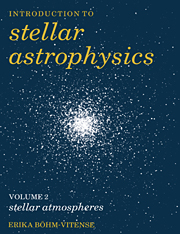Book contents
- Frontmatter
- Contents
- Preface
- 1 Stellar magnitudes and stellar colors
- 2 Stellar spectra
- 3 Temperature estimates for stars
- 4 Basics about radiative transfer
- 5 Radiative transfer in stellar atmospheres
- 6 The depth dependence of the source function
- 7 The continuous absorption coefficient
- 8 The influence of the non-greyness of the absorption coefficient
- 9 The pressure stratification
- 10 Theory of line formation
- 11 The hydrogen lines
- 12 Spectrum analysis
- 13 Basics about non-local thermodynamic equilibrium
- 14 The hydrogen convection zone
- 15 Stellar chromospheres, transition layers, and coronae
- 16 Stellar winds
- Problems
- Appendix LTE model stellar atmospheres
- References
- Index
3 - Temperature estimates for stars
Published online by Cambridge University Press: 08 February 2010
- Frontmatter
- Contents
- Preface
- 1 Stellar magnitudes and stellar colors
- 2 Stellar spectra
- 3 Temperature estimates for stars
- 4 Basics about radiative transfer
- 5 Radiative transfer in stellar atmospheres
- 6 The depth dependence of the source function
- 7 The continuous absorption coefficient
- 8 The influence of the non-greyness of the absorption coefficient
- 9 The pressure stratification
- 10 Theory of line formation
- 11 The hydrogen lines
- 12 Spectrum analysis
- 13 Basics about non-local thermodynamic equilibrium
- 14 The hydrogen convection zone
- 15 Stellar chromospheres, transition layers, and coronae
- 16 Stellar winds
- Problems
- Appendix LTE model stellar atmospheres
- References
- Index
Summary
The black body
If we want to analyse the radiation of stars we must have laboratory light sources with which we can compare the radiation. For instance, if we want to determine the temperature of the stellar gas, we have to know how the radiation of a gas changes with temperature. We also need a light source whose radiation properties do not depend on the kind of material of which it is made, since a priori we do not know what the stars are made of. Such an ideal light source is the so-called black body.
What is a black body? We call something black if it does not reflect any light falling on it. In the absence of any radiation coming from the black body itself, it then looks black because no light falling on it is redirected or scattered into our eyes. If we want to determine temperatures from a comparison with an ideal light source, then this light source must have the same temperature everywhere. This means it must be in thermodynamic equilibrium, which means that it has reached a final state of equilibrium such that nothing will change in time. Such an ideal light source is best realized by a volume of gas inside a well-insulated box with a tiny hole in it. This hole is nearly a perfect black body because any light beam falling into this tiny hole will be reflected back and forth on the walls of this box (see Fig. 3.1) until it is finally absorbed either by the wall or by the gas in the box. The chances of the light getting out of this tiny hole again are extremely small.
- Type
- Chapter
- Information
- Introduction to Stellar Astrophysics , pp. 18 - 25Publisher: Cambridge University PressPrint publication year: 1989

